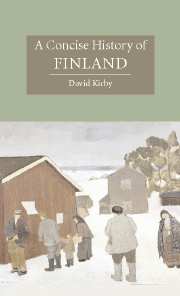Book contents
- Frontmatter
- Dedication
- Contents
- List of illustrations
- Preface
- 1 A medieval marchland
- 2 The Swedish legacy
- 3 From Stockholm to St Petersburg, 1780–1860
- 4 The embryonic state, 1860–1907
- 5 The independent state, 1907–37
- 6 War and peace, 1939–56
- 7 The Kekkonen era, 1956–81
- 8 From nation state to Eurostate
- Key dates
- Presidents of Finland
- Elections and governments
- Notes
- Guide to further reading
- Index
- Cambridge Concise Histories
6 - War and peace, 1939–56
Published online by Cambridge University Press: 05 June 2014
- Frontmatter
- Dedication
- Contents
- List of illustrations
- Preface
- 1 A medieval marchland
- 2 The Swedish legacy
- 3 From Stockholm to St Petersburg, 1780–1860
- 4 The embryonic state, 1860–1907
- 5 The independent state, 1907–37
- 6 War and peace, 1939–56
- 7 The Kekkonen era, 1956–81
- 8 From nation state to Eurostate
- Key dates
- Presidents of Finland
- Elections and governments
- Notes
- Guide to further reading
- Index
- Cambridge Concise Histories
Summary
On 2 December 1939, a new Finnish state came into existence. Declaring that the time had now come to realise the perennial hopes of the Finnish people for a reunion with their close relations, the Karelians, to form a united nation, and to settle the frontier question in a manner satisfactory to both sides, the government of the democratic republic of Finland announced that it had agreed to conclude a mutual assistance treaty with the Soviet Union. The first of the seven articles of the treaty transferred to Finland 70,000 sq. km. of Soviet Karelia, with Finland in turn ceding an area of 3,970 sq. km. in the Karelian isthmus. Finland also agreed to lease for thirty years to the Soviet Union a naval base on the Hanko peninsula, west of Helsinki, and to sell a number of small islands guarding the approaches to Leningrad plus a sliver of land on the Arctic coast.
How had the Finns managed to resolve their differences with their eastern neighbour in such a felicitous manner, at a time when the clouds of war were rolling over Europe? The clue to understanding this document lies in the opening statement, which confidently predicts the speedy liquidation through the heroic fight of the Finnish people and the efforts of the Soviet Red Army of ‘that regular hotbed of war which the former plutocratic government in Finland had created for the benefit of the imperialist powers on the frontiers of the Soviet Union’.
- Type
- Chapter
- Information
- A Concise History of Finland , pp. 197 - 244Publisher: Cambridge University PressPrint publication year: 2006

